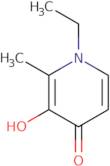1-Ethyl-3-hydroxy-2-methyl-4-pyridinone
CAS: 30652-12-1
Ref. 3D-FE23117
| 1g | Descontinuado | ||
| 2g | Descontinuado | ||
| 5g | Descontinuado | ||
| 10g | Descontinuado | ||
| 500mg | Descontinuado |
Informação sobre produto
- 1-Ethyl-3-hydroxy-2-methyl-4(1H)-pyridinone1-Ethyl-2-methyl-3-hydroxy-4-pyridoneCP 21
- 1-Ethyl-2-methyl-3-hydroxy-4-pyridone
- 1-Ethyl-3-hydroxy-2-methyl-1,4-dihydropyridin-4-one
- 1-Ethyl-3-hydroxy-2-methyl-4(1H)-pyridinone
- 1-Ethyl-3-hydroxy-2-methyl-4(1H)-pyridone
- 1-Ethyl-3-hydroxy-2-methyl-4-pyridone
- 4(1H)-Pyridone, 1-ethyl-3-hydroxy-2-methyl-
- 4(1H)-pyridinone, 1-ethyl-3-hydroxy-2-methyl-
- CP 21 (chelating agent)
- Cp 21
- Ver mais sinónimos
- 1-Ethyl-3-hydroxy-2-methylpyridin-4(1H)-one
1-Ethyl-3-hydroxy-2-methyl-4-pyridinone is a monomeric dye that binds to the protein synthesis apparatus in cells, inhibiting protein synthesis. It has been shown to be more resistant to degradation than other dyes and has high affinity for human CD4+ cells and human macrophages. The mechanism of action for this drug is similar to that of 5-nitrosalicylic acid, which inhibits the production of proteins by reacting with sulfhydryl groups on cysteine residues in enzymes. 1-Ethyl-3-hydroxy-2-methyl-4-pyridinone is also able to inhibit the enzyme reaction by binding to the hydroxyl groups on cysteine residues. The drug has been shown to bind to specific sites on human CD4+ cells and macrophages, as well as other tissues such as bone marrow cells, liver cells, and lymph nodes. 1EHT





